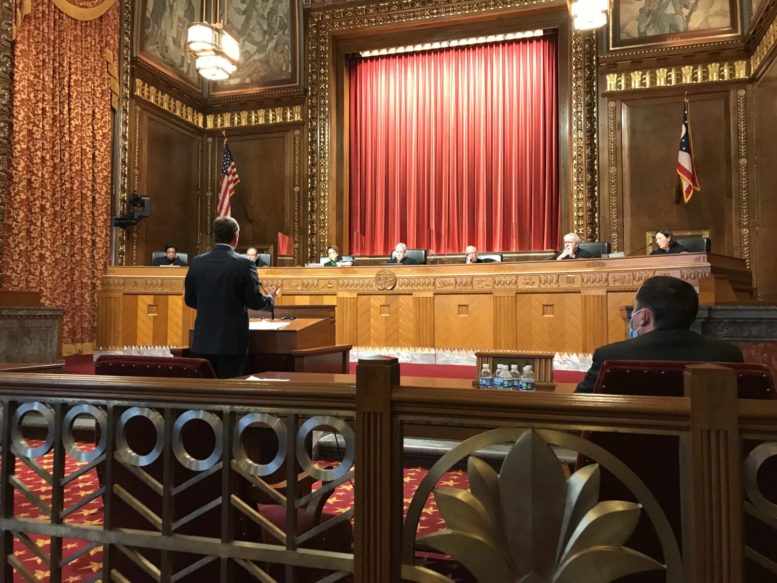BY SUSAN TEBBEN
The Ohio Supreme Court sided with challengers of Ohio House and Senate redistricting maps, saying new maps must be drawn within 10 days.
In a ruling released Wednesday afternoon, the Supreme Court announced a 4-3 decision, saying the Ohio Redistricting Commission “did not attempt to meet the standards set forth” in the legislative redistricting process of the Ohio Constitution. The majority included Chief Justice Maureen O’Connor, often considered a swing vote on the decision.
“Having now seen firsthand that the current Ohio Redistricting Commission … is seemingly unwilling to put aside partisan concerns as directed by the people’s vote, Ohioans may opt to pursue further constitutional amendment to replace the current commission with a truly independent, nonpartisan commission that more effectively distances the redistricting process from partisan politics,” O’Connor wrote in her own opinion supporting invalidating the maps.

Justice Melody Stewart wrote the majority opinion, which directs the ORC to redraw the legislative maps within 10 days, keeping in mind candidate filing deadlines coming up at the beginning of February. Stewart was supported by O’Connor and justices Jennifer Brunner and Michael Donnelly. Justices Sharon Kennedy, Patrick Fischer and Patrick DeWine all dissented.
Points made in oral arguments at the end of 2021 and the decision released on Wednesday both single out Section 6 of the state constitution, which says the ORC “shall attempt” to draw a general assembly district plan that does not favor or disfavor either political party and that uses a state and federal election results to determine “statewide preferences” for Ohio voters.
The court took issue with Senate President Matt Huffman and House Speaker Bob Cupp’s argument to the court that certain parts of the constitution were “aspirational,” specifically, attempting not to favor or disfavor a political party and determining the statewide voter preferences.
“Section 6 speaks not of desire but of direction: the commission shall attempt to achieve the standards of that section,” Stewart wrote in the majority opinion. “While Section 6 contemplates that the standards set forth in it may not come to fruition, it nevertheless requires the commission to try to achieve them.”
In proving that no attempt was made in following the constitution, justices said map challengers provided “undisputed evidence” that the redistricting process was not given a fair shot.
Listing ways in which the process wasn’t followed to the constitutional book, the court said funding for redistricting “was allocated only to the legislative caucuses involved” and members of the commission were not given access to mapping programs “that would have allowed them to meaningfully participate in the drawing of the maps.”
Even under this arrangement, only two commission members – Senate President Huffman and House Speaker Cupp – were involved when the plan that was ultimately adopted was drawn.
– Ohio Supreme Court majority opinion
Not only did the legislative leaders not attempt to comply with constitutional standards, but they “never asked the principal map drawers,” GOP legislative staffers Ray DiRossi and Blake Springhetti “to try to comply with Section 6,” according to the court.
Calculations used to determine the statewide voter preferences, which swung dramatically in Republicans’ favor according to the legislative maps, were not the correct calculations to use, according to the court.
“Senate President Huffman and House Speaker Cupp’s approach looks not to votes cast but to statewide offices won, which is a measure that does not comport with Article XI, Section 6(B) (of the Ohio Constitution),” Stewart wrote.
The proper calculation would lead to a 54% Republican advantage across the state, with 46% Democratic.
The majority opinion also emphasized that the supreme court has the authority over the maps, should they need to oversee the process again. It also pushed back on an argument made by a few people during the public hearing process and from legislative leaders that partisan majority can be fixed by voting out those in the majority.
“The suggestion that the solution to unconstitutional partisan gerrymandering is simply to vote out its perpetrators is disingenuous,” the court wrote. “Partisan gerrymandering entrenches the party in power.”
The state’s highest court went so far as to say the commission “did not attempt to draw a plan” that met the standards in the constitution, but stopped short of deciding whether the plan violated equal rights protections, freedom of assembly and free speech.
A separate federal lawsuit is attempting to invalidate congressional and Ohio Senate maps on equal rights protections violations, but has been put on hold pending the state supreme court decisions.
The Supreme Court seemed to address accusations of perceived partisanship mentioned by dissenting justices in its conclusion to the decision, noting that their analysis and ruling “would be the same regardless of which political party makes up the majority of the commission or drives the map-drawing process.”
“And any disagreement between the members of this court about the legal interpretation of words in the Ohio Constitution does not undermine the integrity of the court or Ohioans’ confidence in it, as the second dissenting opinion fears,” Stewart wrote.
Dissent
Those dissenting opinions came from Kennedy, Fischer, and ORC member Gov. Mike DeWine’s son Patrick DeWine, who chose not to recuse himself from the legislative or congressional redistricting cases.
Kennedy, along with Patrick DeWine, argued the court had an “important but limited role” in reviewing the General Assembly’s district map. She said the majority decided to “disregard” the limits and “rewrite” plain language in the constitution.
“Instead of applying the inconvenient textual limits on this court’s authority set forth in (the constitution), the majority ignores them in favor of its own policy preferences,” Kennedy wrote.
Kennedy said constitutional language did not allow the court to invalidate a district plan based on the Section 6 rules on partisan favoritism or preferences.
On the argument that the redistricting plan as it was approved would dilute some voting power, Kennedy said any plan would dilute at least some voters.
“The remedy provided by the Constitution may not please all Ohio voters, but this court does not have license to demand by judicial fiat the adoption of a new General Assembly-district plan,” Kennedy wrote.
Fischer said his disagreement with the majority of justices included not finding it necessary to even “engage in an analysis of the merits of these cases.”
“The text of the Ohio Constitution is clear, and given the allegations in the complaints, this court lacks the authority to act as requested by the petitioners bringing these case,” Fischer wrote in a separate dissent.
Next Steps
Gov. DeWine, who empaneled the Ohio Redistricting Commission the first time, said he expected the litigation, and is now ready to go back to the drawing board.
“I will work with my fellow Redistricting Commission members on revised maps that are consistent with the Court’s order,” he wrote in a statement Wednesday evening.
The League of Women Voters of Ohio praised the decision of the court as they prepare to move forward.
“Now we call on the Ohio Redistricting Commission to do what voters and the Ohio Supreme Court expect: draw maps that keep communities together and represent the right of every Ohio voter to have fair districts,” said Jen Miller, executive director of the League of Women Voters of Ohio.
Spokesmen for Huffman and Cupp both said the leaders were “reviewing the decision.”
Objections to the new plan are due within three days of adoption of the plan, under the court’s direction.
The court is still considering the congressional redistricting maps, which are also being challenged as invalid.
***
Also from Ohio Capital Journal:
Commentary: Supreme Court dissenting justices on redistricting mock Ohioans’ rights to judicial review
The argument of the three Republican supreme court justices dissenting against the anti-gerrymandering opinion issued by the court 4-3 Wednesday appears to be: Republican politicians are allowed to rig the game in their favor against the wishes of Ohio voters and in violation of the Ohio Constitution, and the Ohio Supreme Court has no authority to stop them.
In the decision, the four-justice majority on the court ordered redrawing of Ohio House and Senate maps that were approved along partisan lines 5-2 in September by the Ohio Redistricting Commission, ruling the maps do not meet the voter-approved standards against partisan gerrymandering in the Ohio Constitution.
The majority has ordered new maps to be submitted within 10 days, and it has retained the authority to review those new maps as well. The filing deadline for partisan candidates in the 2022 election comes in three weeks, on Feb. 2.
In 2015, 71% of Ohio voters amended the state constitution for Statehouse redistricting reform demanding an end to partisan gerrymandering. READ MORE
Judge puts federal redistricting discrimination suit on hold
A U.S. district court judge put a federal redistricting lawsuit on hold Wednesday, treating a pause for a pair of Mahoning County residents’ discrimination lawsuit as “the most efficient use of judicial resources.”
Judge John R. Adams, of the U.S. District Court for the Northern District of Ohio Eastern Division, said the lawsuit relies on multiple other court challenges currently being considered by the Ohio Supreme Court.
The case asked for an immediate redraw of the Ohio congressional district map and the state Senate map due to lack of consideration for the Voting Rights Act and racial makeups in the state. Because racial demographics weren’t considered, the Rev. Kenneth Simon and Helen Youngblood say Black and other minority voting power could be diluted.
Adams said federal courts typically don’t rule on “cases or controversies” which are in the state courts and could be decided in a different way by those courts.
In a 4-3 decision Wednesday, the Ohio Supreme Court ordered redrawing of Statehouse maps approved along partisan lines 5-2 by the Ohio Redistricting Commission, ruling the maps do not meet the voter-approved standards against partisan gerrymandering in the Ohio Constitution. This includes a redraw of the state Senate map. READ MORE





